April 21, 2023
Air Date: April 21, 2023
FULL SHOW
SEGMENTS
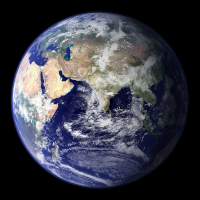
Celebrating Earth Day with John Denver
View the page for this story
Steve Curwood and Bobby Bascomb kick off this Earth Day special with a look back on the memorable 1990 Earth Day. For the 20th anniversary of Earth Day, John Denver took center stage for a massive rally on the National Mall and called for action to protect our fragile planet. (03:46)
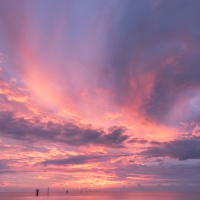
“Earth, Sometimes I Try to Play It Casual”
View the page for this story
Poet Catherine Pierce joins Living on Earth’s Jenni Doering to read her poem, “Earth, Sometimes I Try to Play It Casual” and her thoughts about the meaning of “celebrating the Earth” by being present to the wonders around us. (03:49)
A Children’s Author On Inspiring Kids to Protect the Planet
View the page for this story
Children’s author Lynne Cherry joins Host Bobby Bascomb to describe how a childhood filled with exploring nature led to her career of writing and illustrating stories to inspire kids to protect forests and nature. (04:31)
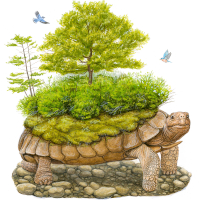
Turtle Wisdom for Earth Day
View the page for this story
Author Sy Montgomery joins Host Steve Curwood to share the multicultural story of the “World Turtle” and why turtles are remarkable creatures and models for human care for the Earth. (03:12)
Connecting With Ancient Sharks
View the page for this story
Though humans and sharks are separated by 420 million years of evolution, Living on Earth’s Explorer in Residence Mark Seth Lender was awestruck by just how similar we are on a recent shark encounter with no cage in the Caribbean. (03:12)
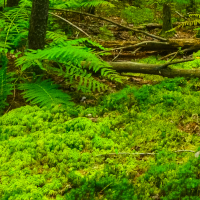
The Little Gods of the Forest
View the page for this story
Poet Major Jackson joins Living on Earth’s Jenni Doering to read his poem, “The Body’s Uncontested Need to Devour, An Explanation” and reflect about forest bathing and immersing ourselves in nature as a vital life-giving experience. (03:10)
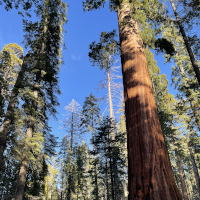
Legends of the Forest
View the page for this story
Writer Jennifer Junghans joins Living on Earth’s Aynsley O’Neill to share her essay, “Legends of the Forest” about a visit to a grove of giant sequoia trees and the stories they hold in their ancient, towering trunks. (05:30)
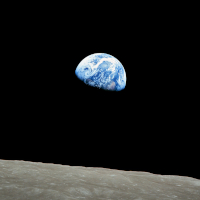
Earth Chats With the Moon
View the page for this story
Master storyteller Jay O’Callahan joins Living on Earth’s Paloma Beltran to share a poetic story about a conversation between the Earth and its friend and companion, the Moon. (01:57)

“Earth Prayer”
View the page for this story
Nulhegan Abenaki storyteller Joe Bruchac joins Host Steve Curwood to deliver his poem of gratitude, “Earth Prayer,” and play the flute. (03:24)
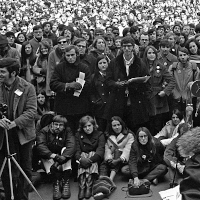
Earth Needs a Movement
View the page for this story
Host Steve Curwood wraps up this Earth Day special with a reflection on the silence of so many who say they are concerned about the Earth amidst its destruction and the climate emergency. (02:37)
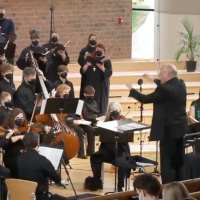
Lament of the Earth
View the page for this story
The orchestral and choral work called “Lament of the Earth” evokes the beauty and wonder of our planet as it speaks directly to the question, ‘where are all the people who care?’ Between excerpts from the 2022 World Premiere of the work, conducting Maestro David Cherwien and Composer Steve Heitzeg join Host Steve Curwood to shed light on its message and inspiration alongside a final reflection from the late lyricist Susan Cherwien. (14:18)
Show Credits and Funders
Show Transcript
230421 Transcript
HOSTS: Bobby Bascomb, Steve Curwood
GUESTS: Catherine Pierce, Lynne Cherry, Sy Montgomery, Mark Seth Lender, Major Jackson, Jenner Junghans, Jay O’Callahan, Joe Bruchac
REPORTERS:
[THEME]
CURWOOD: From PRX – this is Living On Earth.
[THEME]
CURWOOD: I’m Steve Curwood.
BASCOMB: And I’m Bobby Bascomb.
On this 53rd anniversary of Earth Day we celebrate the Earth with special music, poetry and essays .
JUNGHANS: We sink in the snow as we set out among the mythic giant sequoias. It feels as though we have come to a land of legends, as though we are time travelers wandering into an ancient world. Standing before living monoliths 2,000 years old.
CURWOOD: From massive trees old trees to the light touch of wild birds.
CHERRY: I was lying in a field and I fell asleep. And I woke up because gold finches were flying so close to me that their wings were brushing my face. And then I closed my eyes and they landed on me. I felt like it was a blessing, like I had been accepted into this wild kingdom.
CURWOOD: That and more this week on Living on Earth – Stick Around!
[NEWSBREAK MUSIC: Boards Of Canada “Zoetrope” from “In A Beautiful Place Out In The Country” (Warp Records 2000)]
[THEME]
Celebrating Earth Day with John Denver

NASA Blue Marble of the Earth's Eastern Hemisphere. Composition of images taken by Moderate Resolution Imaging Spectroradiometer (MODIS), flying on board of the sattelite Terra, by NASA. (Photo:Wikimedia Commons, NASA)
CURWOOD: From PRX and the Jennifer and Ted Stanley Studios at the University of Massachusetts Boston, this is Living on Earth. I’m Steve Curwood.
BASCOMB: And I’m Bobby Bascomb.
Today we are celebrating the Earth and Earth Day, with some music, poetry, and storytelling.
CURWOOD: Earth Day as an expression of caring for the Earth is a movement with moments, including its twentieth anniversary back in 1990, when I produced the first pilots for this show and John Denver took center stage for a massive earth day rally on the National Mall in front of the Lincoln Memorial.
[Rocky Mountain High Song]
DENVER: Thank you very much. And once again Happy Earth Day. Buckminster Fuller, who was a dear friend of mine, the grandfather of the future, in many of our opinion, said that the major challenge that faces the human race is a metaphysical one. And that is to educate people to the degree that spontaneous behaviors sprang forth behaviors which will ensure this level of our species. Today, people all over the world are gathered together, people who have heard that voice, and who have begun that education and are willing now to take the second step, which is to translate our knowledge into action. We see a world of clean air to breathe, and clean water to drink. We see a world without home hunger and homelessness. We see our hunger with a world without nuclear weapons, a world in which all people are working together to create a sustainable future and a healthy environment.
CURWOOD: John Denver at the 1990 Earth Day celebration on the national mall.
Related link:
Watch John Denver’s 1990 Earth Day performance
[APPLAUSE]
“Earth, Sometimes I Try to Play It Casual”
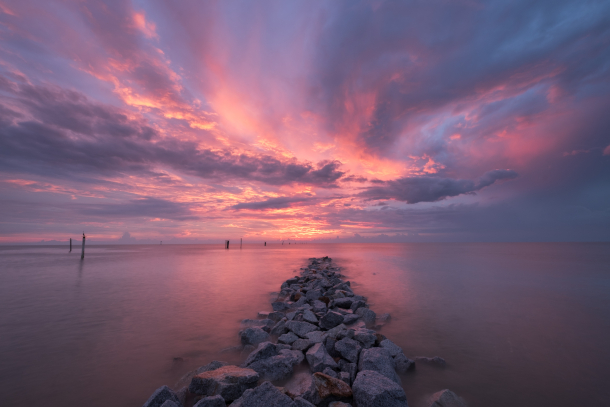
“Earth, what I want is to sit gentle under your twilight purple.” – Catherine Pierce (Photo: Bowen Chin, Unsplash)
CURWOOD: Now Living on Earth’s Jenni Doering is here with one of our favorite poets.
DOERING: Yes Steve, I spoke with acclaimed poet Catherine Pierce about her poem, “Earth, sometimes I try to play it casual.” First let’s listen to her read the poem.
Earth, Sometimes I Try to Play It Casual
like Hey mercury, hey malachite, I’m busy today,
can’t stop to marvel, but always my blood is saying
O god you starsprung miracle. It’s self-preservation,
letting myself believe laundry matters,
letting myself believe there’s anything other than
egrets and oceans and vast moss carpets and
the finite heart of every single person I love.
Earth, you terrify me—you are fierce green
and honeysuckle, you are herds of wild ponies,
and you are leaving, always. Is it any wonder
some days I look at my laptop instead of out
the window? Every time I glance up
there you are, quaking me with your fern fronds
and silver frost. O you of the rhyolite mountains.
You of the dew-hung web. You are lemon quartz
and quicksand. Muskrats and starfish. How
could I be any way but staggered? O blue spruce,
O white fir, O green forever, you know
my nonchalance is a sham. It’s so hard to admit
our real desires. Earth, what I want is to sit gentle
under your twilight purple, watch your bats
hunt and dive. What I want is to know about
endings and still love each wingbeat, each shade
of the boundless, darkening sky.
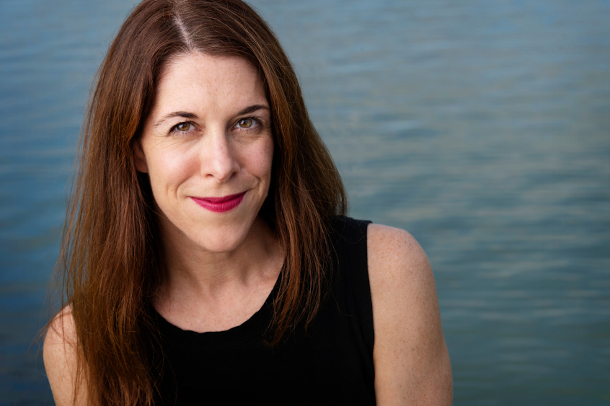
Catherine Pierce is the author of four books of poems including Danger Days and The Tornado Is the World and is professor of English and co-director of the creative writing program at Mississippi State University. (Photo: Megan Bean / Mississippi State University)
DOERING: We’re calling this a celebration of the earth because I think it's easy for us to forget just how lucky we are to be walking around on this planet, our one and only home. What is the phrase "celebration of the earth" mean to you when you hear that?
PIERCE: To me, it means a couple of things. It means acknowledging everything, being aware of everything, sort of taking that moment to say, oh my gosh, I'm looking out my window right now, and I'm seeing daffodils that are starting to bloom and some hyacinths back there. And I live by the woods, and I can see these turkey vultures, always turkey vultures flying overhead. And it's amazing, I mean, turkey vultures are terrifying, but they're also absolutely incredible creatures. They're huge. And I see them every day. And I think, wow, this is an amazing thing to be looking at. It's just by my house and I get to watch these birds fly around. So I think part of celebrating the earth is taking those moments to just be aware of these things, to pay attention to all these things around us. And then I think the other part of it for me is finding a way to let ourselves experience the joy of this planet and all of its wonders, even as we're aware of the crisis that it's in. To give ourselves permission to say, yeah, we can enjoy this, we can celebrate this, we can marvel over this and also be aware that there is a very, very serious problem that is continuing daily and getting worse and that we need to fix. And so I think celebrating is a huge part of that. The celebration is what can kind of help spur us to action to make things better.
DOERING: Thanks! Catherine Pierce is the poet Laureate of Mississippi. Her latest book is called Danger Days.
Related links:
- Catherine Pierce’s website
- Find Catherine Pierce’s book of poetry, “Danger Days”, here (Affiliate link supports LOE & indie bookstores)
[MUSIC: MUSIC: Blue Dot Sessions, “Skyforager”]
A Children’s Author On Inspiring Kids to Protect the Planet
One of Lynne’s Cherry’s most well-known books is The Great Kapok Tree (Photo: Courtesy of Lynne Cherry)
BASCOMB: So today as part of our Earth Day Celebration we have filmmaker, illustrator, and author Lynne Cherry. Lynne is perhaps best known for her children’s book, The Great Kapok Tree. Her journey to writing started in the woods behind her family home in Pennsylvania.
CHERRY: When I was little girl, we live by a woods and it was where I spent most of my waking hours. I just loved every square inch of it. I used to go sit absolutely still and I learned that if you don't move, that it's like you're invisible and all the animals come up, and they land on you, they poke you. You get to see what the natural world is like, when you're not there. I was lying in a field, and I fell asleep and I woke up, because I felt this really soft, something really soft brushing my face. And I opened my eyes just a little bit and it was this bright gold flashing by and then when I opened them a little bit more, it was goldfinches and they were flying so close to me that their wings were brushing my face. And then I closed my eyes and they landed on me. I felt like it was a blessing. I felt like I had been accepted into this wild kingdom. A lot of the times when I was sitting there I was drawing, I was looking at what holes in the trees, different animals lived in. I was realizing that like every nook and cranny, there's something living in it and I just got so I knew where each animal lived. So I would write stories.
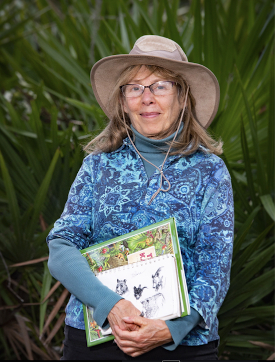
Lynne Cherry is the author and illustrator of several children’s books. (Photo: Dustin Angell)
I brought my paper and pen and sat there and wrote stories and did drawings. And my first books were these just little books, folded paper with crayon drawings of my adventures. I kept all those books, so I kept, I have a box with all these little children's stories in it. And I found one as an adult. And I brought it to my publisher and she said, this is a really good story but you've improved as an illustrator since you were eight, so could you redo the illustrations and we'll publish the book. And that was this book that was actually published. I actually think I wouldn't have been creative If I hadn't had those hours, sitting by myself, watching nature, letting my imagination run free writing, drawing, and getting to know the animals kind of personally. It's like a meditation. I think it's really important for kids to have that kind of time. I was eight years old when I came home one day and they were bulldozing my woods. I felt like the adults didn't know what they were doing. They had no idea what that what was there when they were destroying it. Maybe they didn't care. And so I felt like I couldn't do anything back then but then as I got older, I realized kids do have power, and that kids can save forests. And so I started sharing the stories of kids who had saved forests with other kids and then they went out and saved forests. And then I have devoted my life to helping people to save the forest in their own backyards. And that's really exciting to me that they are speaking up to save the places that they love.
BASCOMB: Author Lynne Cherry
Related links:
- Lynne Cherry’s Website
- Find The Great Kapok Tree (Affiliate link supports LOE & indie bookstores)
[MUSIC: MUSIC: Blue Dot Sessions, “Skyforager”]
Turtle Wisdom for Earth Day

An artistic representation of the World Turtle. (Photo: Matt Patterson)
CURWOOD: With me now is author Sy Montgomery. Waddya have for us to help us celebrate Earthday?
MONTGOMERY: I've got turtles! [LAUGH] I just I love the symbol of our Earth Day. I love that photo of the blue marble taken from space by the crew of Apollo 17 on their way to the moon. But I also love an image of our earth that's much older than that. It's known in many cultures as the world turtle. In Hindu and Buddhist mythology, a tortoise called Akupara carries the world on his back, upholding the earth and the sea. In North America Haudenosaunee, Lenape, and Abenaki creation stories.

Sy Montgomery’s “Of Time and Turtles” is an upcoming narrative nonfiction book. (Photo: Courtesy of Sy Montgomery)
The Great Spirit creates the homeland by placing Earth on the back of a huge turtle. Many still refer to North America as Turtle Island. And indeed, ours is the continent boasting the most turtle species in the world. It's no wonder that turtles, creatures who arose with and outlasted the dinosaurs, are honored by so many cultures, from Alaska's Admiralty Island to Polynesia. Native peoples say the world turtle laid the eggs that hatched into the first humans. Who wouldn't be proud to claim such a storied ancestor? Almost everyone loves turtles, for their beauty, for their remarkable longevity, and for their patience. A balm to soothe the hurry of the human world. Everyone knows turtles. Yet turtles also surprise us. They're more exciting than most of us realize.
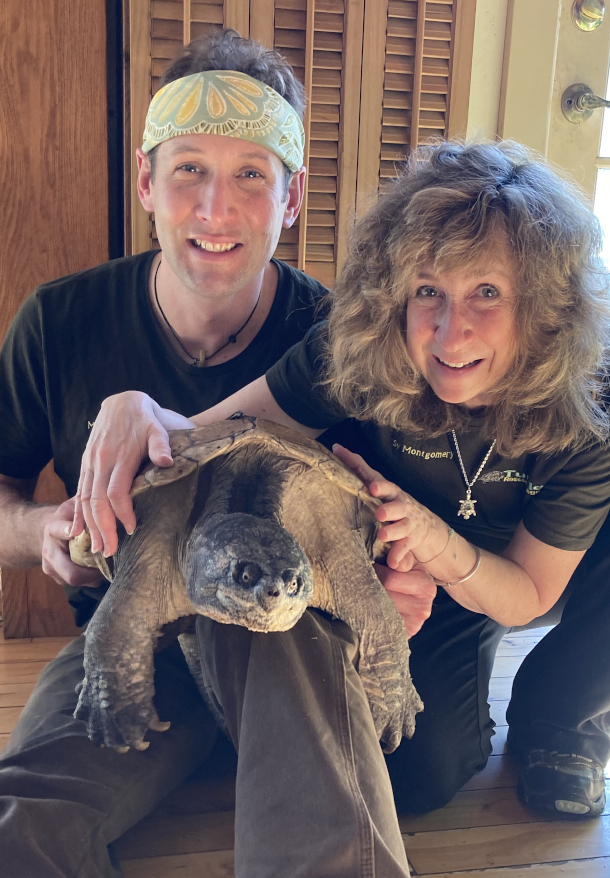
Sy Montgomery (right) with her illustrator Matt Patterson (left) and a turtle (center) named Fire Chief. (Photo: Courtesy of Sy Montgomery)
Many are vocal, some bark, some whistle. Some begin talking with their siblings and mother even while they're still unhatched babies still in the egg. Turtles may seem slow, but they're smart. Some species outperform rats in mazes. Though they're slower movers, they're faster learners. They have no ears, yet they can hear a human whisper. They help others in distress. Sometimes several will work together to flip a turtle who's upside down. In China, the world turtle is named Ao. The Creator goddess uses his legs to prop up the heavens. Without the turtle, we're told, the very sky would fall and it's true. Turtles are the foundation for many ecosystems. The Hawksbill Sea Turtle protects coral reefs from correlating sponges, gopher tortoises burrows shelter a dozen other species, many of which couldn't live without them. But these creatures who survived the asteroid strike may not survive us.
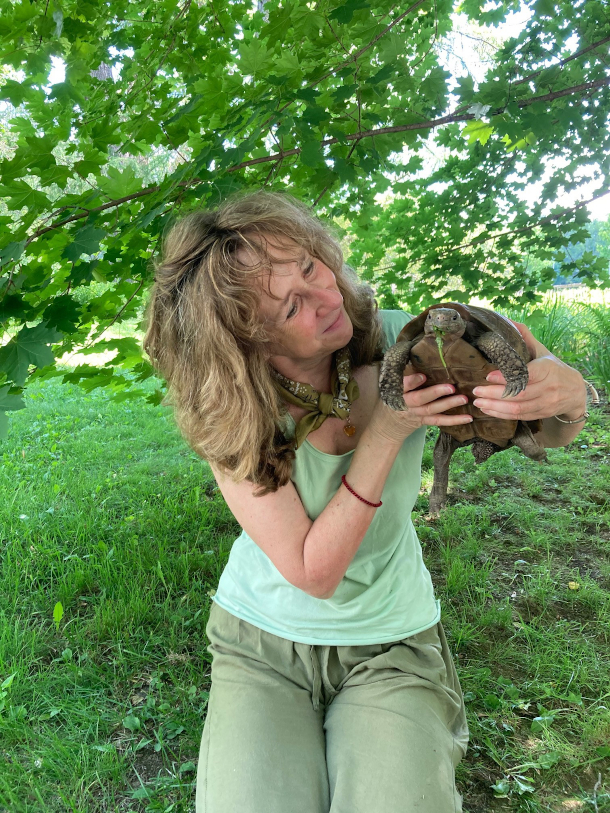
Sy Montgomery with turtle Lucy. (Photo: Courtesy of Sy Montgomery)
They're among the most endangered vertebrates on earth. Well over half of the more than 300 species of turtles are in dangerous decline. The usual suspects are at fault. Roads, pollution, sprawl, climate change, plus a deadly and rapidly growing illegal trade in turtles for medicines, pets, and ornaments. So my wish for Earth Day is that we remember turtle wisdom. Even now, a moment in history when it feels like the sky is falling, turtles remind us that we can find a way to regain our connection with creation. My prayer is this: that these strong, slow, smart ancient creatures inspire us. Like the world turtle. It's time we take our turn upholding our fragile blue marble Earth.
CURWOOD: Thanks, Sy. Sy Montgomery is the author of The Book of Turtles with art by Matt Patterson, published May 2nd 2023 by Harper Collins.
Related links:
- Visit Sy Montgomery’s website
- Pre-order Sy Montgomery’s picture book, “The Book of Turtles” here (Affiliate link supports LOE & indie bookstores)
- Pre-order Sy Montgomery’s book of narrative nonfiction, “On Time and Turtles: Mending the World, Shell By Shattered Shell” here (Affiliate link supports LOE & indie bookstores)
- Watch the trailer of Sy Montgomery’s “The Book of Turtles” here
- Artist Matt Patterson's website
[MUSIC: MUSIC: Blue Dot Sessions, “Tools and Practices”]
BASCOMB: Coming up – We’ll continue our celebration of the Earth and some surprising relationships we can form with wild creatures.
ANNOUNCER: Support for Living on Earth comes from Sailors for the Sea and Oceana. Helping boaters race clean, sail green and protect the seas they love. More information @sailorsforthesea.org.
[CUTAWAY MUSIC: MUSIC: Blue Dot Sessions, “Gaena”]
Connecting With Ancient Sharks
When cage-free diving with Caribbean reef sharks, one must wear a chain mail suit to protect against accidents. (Photo: Mark Seth Lender)
CURWOOD: It’s the Living on Earth Earth Day special, I’m Steve Curwood.
BASCOMB: And I’m Bobby Bascomb.
Mark Seth Lender is our explorer in residence who has brought us many thoughtful essays about his interactions with wildlife. And his beautiful photographs can be seen on our website, LOE.org. As we celebrate Earth Day he says we are also celebrating ourselves:
LENDER: I think we're all sort of aware of how beautiful nature is. Anyone who's seen the sunrise on a winter day or seen a flock of birds in a murmuration, making all those patterns in the sky, you know, we're all kind of aware of that.
But we sort of tend to slip into this thing of thinking of it being different from us, you know, apart from us, particularly wild animals. But the thing that really astounds me, and continues to astound me after 35 years, is how much like us wild animals can be. So one of the few things I hadn't done was diving with sharks.
The sharks are curious about Mark, the unfamiliar diver in their midst. (Photo: Mark Seth Lender)
And these are cage free dives. They're with sharks called Caribbean reef sharks that are, you know, 7, 8, 9 feet long, 150, 170 pounds. And we are three divers, all of us in chainmail suits made out of stainless steel, which is not because you expect to get eaten, but it's a protection against mistakes, really. So for all intents and purposes, if you're a shark, you would think we all look alike. But no, the sharks figured out they hadn't seen me before. Two of the divers, the sharks are familiar with.
The animals investigate Mark by swimming over, under, and beside him. (Photo: Mark Seth Lender)
And they paid a fair amount of attention to the other two, but the person they really came to and surrounded and swam around was me, with a regulator in the middle of my face, and a mask covering my eyes, and brow ridge, and my nose, and you know, all of the things that give our faces their features and their singularity. And yet, they knew I was different. And they were interested in me. And they came up to me and they surrounded me. And when they went all around and over me and down beside me, and they looked me in the eye. So when you put all that together, I mean, I have goosebumps talking about it. You know, you expect to be recognized and understood by elephants.
Sharks are some of our most distant relatives. (Photo: Mark Seth Lender)
I've had polar bears come up to me and look at me and stand there with their paws in front of their chests, just like a squirrel looking at you going, what are you guys? But to have it with sharks--we don't have a common genetic ancestor with a shark for 420 million years. They're almost as far from us as insects. And yet they saw me, and they knew me. And they understood I was a being and different from the other beings who for all intents and purposes looked just like me. And I think there can be no greater testimony to the magnificence and unity of life on Earth than that.
BASCOMB: Living Earth’s explorer in residence, Mark Seth Lender.
Related link:
Mark Seth Lender’s website
[MUSIC: MUSIC: Blue Dot Sessions, “Crown of September”]
The Little Gods of the Forest
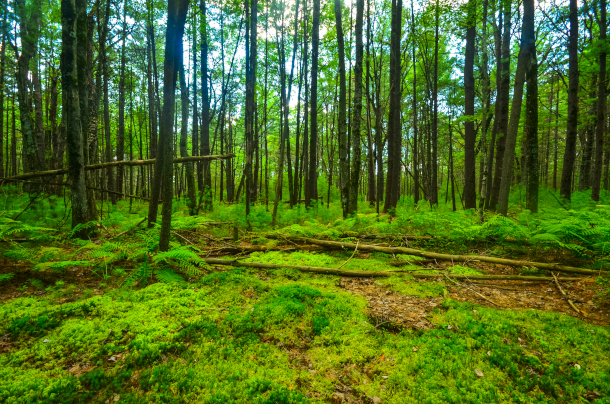
Major Jackson’s poem the Body’s Uncontested Need to Devour, An Explanation is inspired by the moss he sees during his long walks across the Vermont forest. (Photo: Joshua Mayer, Flickr CC BY SA 2.0)
CURWOOD: And we are joined again now by Living on Earth’s Jenni Doering.
DOERING: Yes we asked poet Major Jackson to help us celebrate Earth Day, and he selected his poem “The Body’s Uncontested Need to Devour, An Explanation.”
The Body’s Uncontested Need to Devour, An Explanation
I am bathing again, burying my face
into the great nations of moss.
I am leaning in, smelling the emerald mountains
and the little inhabitants crossing
over rock-like boulders and tree trunks empired
bit by bit. My nose must come to them
like a probing spaceship causing a mighty eclipse.
They speak in whispers but do not shriek
when gazing into the dim landing bays
of my cavernous thoughts. I am grazing
like a Dionysian. I come not with religion.
I come yearning for first spring and a thirst for spores
pooling like mercenaries in the dark even as we speak.
The little gods of the forest live here.
I want to ingest their verdant settlements
until they carpet my cavities and convert my raptorial
self into its own ecosystem, off into the green.
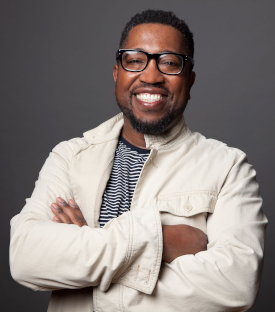
Major Jackson is an American poet and professor at Vanderbilt University. (Photo: Patrice O’Brien)
DOERING: Towards the end it seems like you are contemplating dissolving into this green world, into this ecosystem. Can you talk about that?
JACKSON: Yeah. Well, we've all heard the term forest bathing now and Shinrin-yoku and the idea of healing through nature. And some part of me experiences that every time I go out as a transformation of sorts. And so, in that particular instance, I am alluding to that feeling that I get. But I also as a Dionysian, you know, someone who wants to not only experience that healing but also someone who believes that this is how we remain alive. We are part of the biodiversity that makes up our ecosystem, so that interrelatedness, that sense of life giving life is kind of what I'm exploring there. Which may mean interestingly enough, now that you pose that question there, which may mean a dissolving into the world around us, which we know we're eventually going to do. So there's this wonderful kind of tension there.
DOERING: Major Jackson is a poet Professor at Vanderbilt University and the host of the Slowdown Podcast. Thank you so much for joining us Major.
JACKSON: Thank you Jenni, my pleasure.
Related links:
- Learn more about Major Jackson
- Major Jackson’s profile from the Poetry Foundation
- The New York Times | “The Body's Uncontested Need to Devour, An Explanation”
- Orion Magazine (No paywall) | “The Body’s Uncontested Need to Devour, an Explanation”
- Pre-order Major Jackson’s forthcoming book of poems “Razzle Dazzle”
- Follow Major Jackson on Instagram
- Listen to “The Slowdown” podcast, hosted by Major Jackson
[MUSIC: MUSIC: Blue Dot Sessions, “Upholding”]
Legends of the Forest
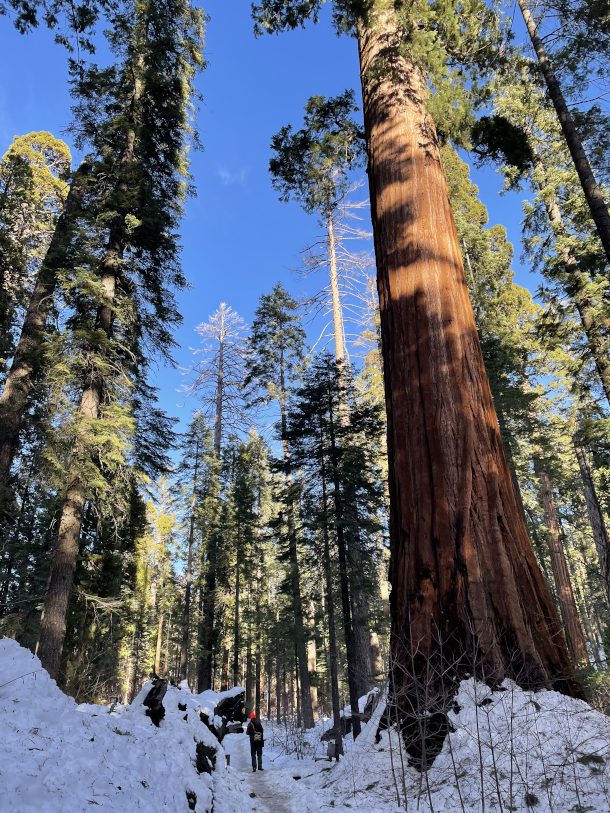
Jennifer Junghans’ best friend Matthias Rös among the giant sequoias at Calaveras Big Trees State Park in California. (Photo: Jennifer Junghans)
BASCOMB: Living on Earth’s Aynsley O’Neill is here now with writer Jennifer Junghans as we continue our celebration of Earth Day.
O’NEILL: Jennifer Junghans has produced commentaries for us that range from stories about the most distant stars to the challenges of a mother coyote living in the city.
In honor of Earth Day, she wrote an essay, called Legends of the Forest.
Big Trees: Legends of the Forest
We sink in the snow as we set out among the mythic giant sequoias. It feels as though we have come to a land of legends. As though we are time travelers, wandering into an ancient world, standing before living monoliths 2,000 years old. We touch their trunks — some as wide as a theater’s stage — and we strain to look upward, following their reach into the sky hundreds of feet, piercing a realm outside of Earth’s. They are stately and reverent, but my mind runs wild with the secrets they know and the stories they could tell.
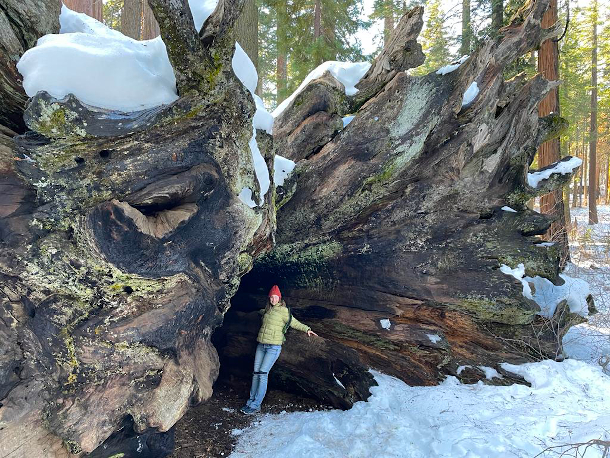
Jennifer Junghans at the base of an old fallen giant sequoia. (Photo: Matthias Rös)
Stories of survival and death, love and loss, victory and defeat of the people, the animals and the forest itself. All of life has happened across millennia in this very place. The generations of Miwok and Washoe people who lived in this forest and came to know these giants. And Augustus T. Dowd, who stumbled upon this grove in 1852 as he stalked a wounded grizzly bear. His discovery drew flocks eager to carve up this priceless old growth for profit. And the wounded bear who fled from Augustus to the forest for cover. Did he brush against the trees we touch? Clamber up them? Did he see what we see? Do we stand upon his final resting place?
The sequoia know. And they have their own stories. Their bodies scarified with the passage of time told in gnarls and hollows, trunks grown askew and walls of charcoal from lightning bolts that spare no one.
As we stop to rest, my friend Matthias pulls out chocolate and we savor it like a sacrament here in the forest. In the quiet I can’t help but think of the abundance of life that calls this place home. Foxes, flying squirrels, porcupines, owls, pileated woodpeckers, bobcats and bears. I wonder if in their mastery of their environment they are watching us as I daydream of watching them.
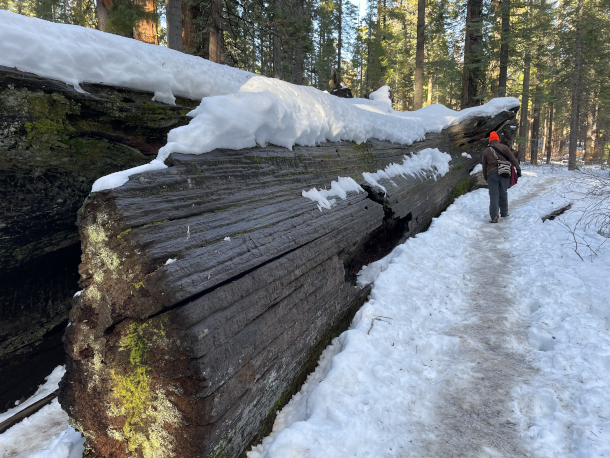
Matthias Rös walking through the snow alongside an old sequoia trunk. (Photo: Jennifer Junghans)
We weave along the forest floor. We’re looking for the mammoth of a hollow fallen tree. We hope to walk through it, but the storm has flooded it and it looks like a half sunken ship from medieval times. Instead we go to opposite sides to wave at each other from afar like kids do through tunnels.
The lengthening shadows tell us it is time to leave but I’ll always return to this true north where life endures. Something that will outlive us and generations to come, but only if we tread lightly and choose to fiercely protect this fragile ecosystem. Where the sequoias are the oldest living recorders of the region’s history, folding our complicated, messy and beautiful stories into their own. Where we can come to see and feel and touch vaults of time in these statues that live in the forest.
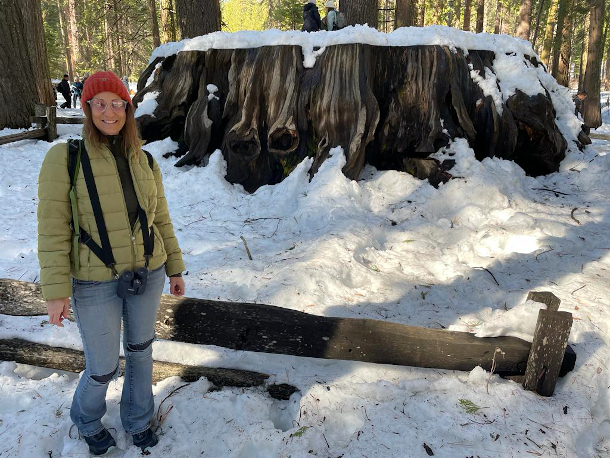
Jennifer Junghans near the enormous stump of a felled giant sequoia. (Photo: Matthias Rös)
O’NEILL: Well, we've been thinking a lot about the concept of celebrating the earth for this Earth Day special. To you, what does it mean to celebrate the earth? And how is that reflected in this story?
JUNGHANS: Well, we do have such an amazing planet that is worth celebrating every day. And for me, visiting these trees, there's an innate value to them simply because they are, there's this intrinsic value because they are simply so beautiful and overwhelming in their, in their beauty and their presence. And at the same time, you know, we have to think about the value of these trees as a natural resource. And everything that they provide to all life on Earth, I mean, they clean our water and they absorb our greenhouse gases and they produce oxygen that we breathe and they provide the shelter and food and habitat for countless flora and fauna and, and this is simply by, by being alive -- this is simply what they do.
O’NEILL: Writer Jennifer Junghans
Related links:
- Jennifer Junghans’ website
- Learn more about Calaveras Big Trees State Park
[MUSIC: MUSIC: Blue Dot Sessions, “Fill and Forage”]
Earth Chats With the Moon

CURWOOD: Living on Earth’s Paloma Beltran is with us now, with a story from the great Jay O’Callahan.
BELTRAN: Jay O’Callahan is a master storyteller who has shared some of his most vivid original stories with Living on Earth listeners over the years. And when we asked him to help us celebrate Earth Day he spoke of friendship.
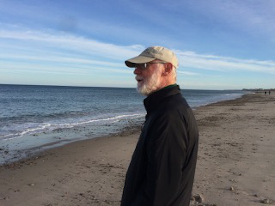
Jay O'Callahan on the beach. (Photo: Paul Kennedy, Courtesy of Jay O'Callahan)
Jay O’Callahan
A story of Earth for Earth Day
© April 12, 2023
O’CALLAHAN: Earth's good friend is the Moon. The Moon goes around the earth every day. One day Moon said, "Earth you've told me about all of your problems. Pollution and all. But you've not told me why you like being Earth." “Oh” said the Earth. " I like my seas and my trees and my bees and even my fleas. I like all of my motions and my salty old oceans. And worms! And their squirms. I have trillions of worms. They make tunnels. The rainwater slips down the tunnels like funnels and waters the roots of the flowers. Flowers poke up above ground and there are millions of flowers allaround--red, yellow, blue. Every hue. People excited come running and they sing. "You've done it again, Earth. You've brought Spring! They are so happy and so am I dear Moon because people are help finding solutions to the pollutions and all. Isn’t that wonderful. I feel like dancing, don’t you?”
BELTRAN: Storyteller Jay O’Callahan
Related link:
Storyteller Jay O’Callahan’s Website
[MUSIC: MUSIC: Blue Dot Sessions, “Kilkerrin”]
“Earth Prayer”
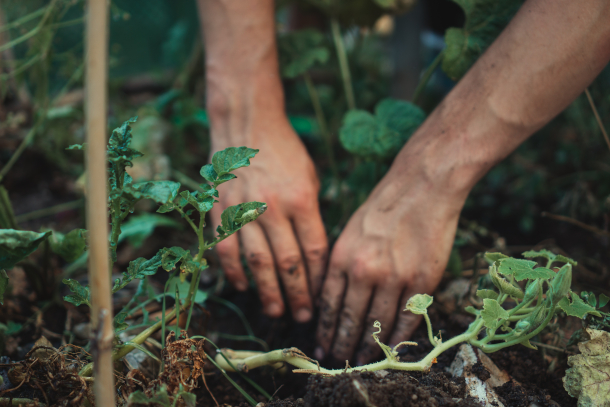
Joe Bruchac’s poem is dedicated to Mother Earth. (Photo: Jonathan Kemper, Unsplash)
On the line now from Porter Corners, New York is Joe Bruchac, Nulhegan storyteller and poet. We're celebrating Earth Day, Joe, good to talk to you again. How you doing?
BRUCHAC: Oh, I'm good, kwai kwai nidôbak, hello my friend.
CURWOOD: And what do you have for us today for the celebration?
BRUCHAC: I have an original poem that I wrote just for this occasion. It's based on traditions among the Haudenosaunee the Iroquois people, and the Wabanaki, my own people, of giving thanks and acknowledgement for the gifts that we often take for granted that are all around us. It's called Earth prayer.
© 2023 Joe Bruchac
EARTH PRAYER (Adapted from Haudenosaunee and Wabanaki traditions)
Because this Earth is our first mother
we say Ktsi Wliwini, mina ta mina--
Great Thanks, again and again.
Because all our ancestors could see
the rain that falls, the air we breathe
the healing waters, the giving stones
our mother’s blood, our mother’s bones
are gifts we have been given.
Joseph Bruchac is an author of more than 120 books for children and a member of the Nulhegan Abenaki Nation. (Photo: Courtesy of Joseph Bruchac)
It is from this Earth that all our lives,
those who came before us, those yet to come
like the seeds that sprout with each new spring
have grown, have grown, have grown.
And what does this Earth ask of us?
All that it asks is that we never
take too much, always remember
to give back in equal measure
for those gifts we may take for granted.
And also remember that we must
walk with care, always show kindness
to all those now here with us
sharing gifts of life and light,
never forget those who share our breath
two-legged, four-legged, those with wings.
those who swim or dig into the soil,
the grass, the trees, all living things
from the greatest to those too small
to see are also related, one and all,
Wli dogo wongan, all our relations.
So, as we continue on this circle
which has no beginning and no end
let us all say to our Mother Earth
Ktsi Wliwini, mina ta mina--
Great Thanks, again and again.
CURWOOD: Thank you, Joe Bruchac.
BRUCHAC: Doc hug we don't mention it. You are very welcome.
CURWOOD: Hey, did you bring your flute with you?
BRUCHAC: I did. I thought the flute would be a good addition to this. The flute really is connected in so many ways to those gifts from this earth from this place. The flute is basically the hollow branch of a tree that has had holes pecked into it by a woodpecker. And what I'm going to do is improvise a song and I think within it you might be able to hear the wind, the sound of the birds and think of the heart of the tree and our own breath that we share when we play a flute.
Related links:
- Storyteller Joe Bruchac’s Website
- More on the Nulhegan Abenaki Nation
[MUSIC: Joseph Bruchac Flute Song]
BASCOMB: Coming up – Music to celebrate mother earth. Stay tuned to Living on Earth.
ANNOUNCER: Support for Living on Earth comes from Friends of Smeagull the Seagull and Smeagull’s Guide to Wildlife. It’s all about the wildlife right next door to you! That’s Smeagull, S - M - E - A - G - U - L - L, SmeagullGuide.org.
[CUTAWAY MUSIC: MUSIC: Blue Dot Sessions, “Kilkerrin”]
Earth Needs a Movement

Students gather for a rally during Michigan’s 1970 Teach-In on the Environment. (Photo: University of Michigan School for Environment and Sustainability, Wikimedia Commons CC BY 2.0)
BASCOMB: It’s the Living on Earth Earth Day special. I’m Bobby Bascomb.
CURWOOD: And I’m Steve Curwood.
DICAPRIO: The problem with doing a speech concerning our environment is that there is so much to say about so many issues. [Cheers SFX]
CURWOOD: With the US Capitol building as a backdrop Hollywood star Leonardo DiCaprio spoke as chair of the 30th anniversary of Earth Day in the year 2000.
DICAPRIO: With the ever increasing population and the constant need to tap into the planet’s non renewable resources we are quite frankly creating our own scenario for disaster. Which brings us to the solution. Clean energy now and the theme of this year’s Earth Day.
CURWOOD: But more than two decades later and despite speeches by famous people like Leonardo DiCaprio, and numerous political promises we are many more gigatons of carbon deeper into the climate crisis. The related wildfires, tornadoes, storms, and floods now make headlines almost every day. And even as the climate crisis advances, along with ever more toxic pollution and habitat destruction for countless species, Earth Day has become a shadow of itself, and yes, now more of a moment in April than a movement. The millions who rallied on the first Earth Day are mostly down to just a few thousand who plant trees, clean up beaches or hold local marches to rebel against extinction. Those huge first Earth Day rallies prompted bipartisan elected officials in the US to create the Environmental Protection Agency, the Clean Water Act, the Clean Air Act and more. And despite discord over the War in Vietnam, there was the promise we would rise to address to environmental challenges even greater than the famous Cuyahoga River fire in Ohio that helped inspire that first Earth day. But fifty years later with much of the planet itself now on fire, when it comes to the environment much of the public is not. One could blame the partisan divide or the big lies that some commercial interests have promulgated. But I am tempted to think that too many of us, including the millions who now stay home from Earth Day rallies, have forgotten how democracy works. Those who advanced democracy here have marched, whether to dump tea in Boston Harbor in 1773 or cross the Edmund Pettis bridge in Selma, Alabama in 1965. Now it seems the most Earth-friendly marches we make are from the kitchen table to the recycling bin, and true recycling is often dubious. I’ve never met anyone who doesn’t love our planet and the life it gives us. Why then, are so many of those who say they are concerned about the Earth merely standing in silence?
Related link:
Leonardo DiCaprio’s Earth Day 2000 speech
[MUSIC: Earth Aria II
Music: Steve Heitzeg Libretto: Susan Palo Cherwien
The National Lutheran Choir with Orchestra, David Cherwien, Artistic Director
The Minnesota Boy Choir, Mark Johson, Executive and Artistic Director
Clara Osowski, Mezzo Soprano, David Trembley, Soundmaster Productions
David Trembley, Soundmaster Productions
Lament of the Earth © 2023 National Lutheran Choir ]
Lament of the Earth
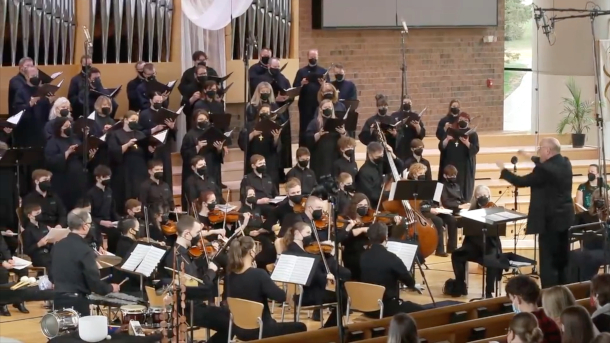
David Cherwien conducts the premiere performance of Lament of the Earth. (Photo: courtesy of Flight Creative Media)
CURWOOD: The silence of the concerned is a theme of an orchestral and choral work called Lament of the Earth. So as we bring our celebration of the Earth and Earth Day to a close, we turn to some excerpts from the World Premiere in 2022 of Lament of the Earth. We typically don’t present classically styled music on Living on Earth, but this work evokes the beauty and wonder of our planet as it speaks directly to the question, ‘where are all the people who care?’ The score for Lament of the Earth was composed by Steve Heitzeg with many of the lyrics by the late poet Susan Cherwien. With mezzo soprano Clara Osowski as featured soloist, David Cherwien conducted its world premiere as artistic director of the National Lutheran Choir. I asked Maestro Cherwien how Lament of the Earth was born.
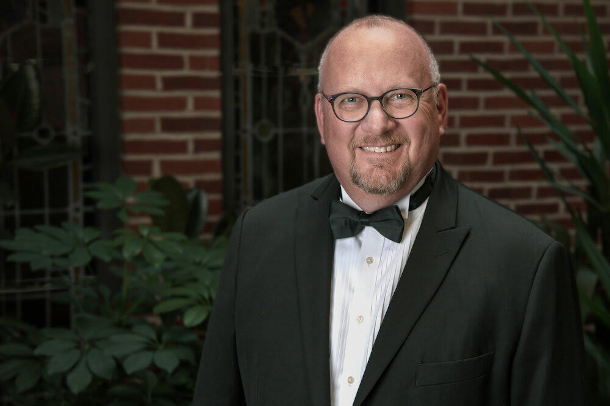
David Cherwien is the artistic director of the National Lutheran Choir and conducted the premiere performance of Lament of the Earth. (Photo: Leslie Ortiz)
CHERWIEN: Well, the idea came about through a series of things. But my wife, Susan, and I have often had expressed concern about the care for the earth, and also meeting with friends who are indigenous American Indians and their whole understanding of the Earth, as a living being as a living, nurturing, being like a mother, calling Mother Earth, combined with our were involved in a Christian church, which on Good Friday, makes use of the what we call the reproaches, which is Jesus on the cross saying, Oh, my people, what have you done to me, I did this and that for you. And this is what you do in return. And I just imagined if that voice were given to the earth with that same sentiment, and I think that that, that sort of led to the word lament being involved. So it kind of grew from there out of a deep concern for the earth, and how the arts can speak to that, and, and have some give the earth a voice in that process. And so that’s how it began.
[MUSIC: Earth Aria
Music: Steve Heitzeg Libretto: Susan Palo Cherwien
The National Lutheran Choir with Orchestra, David Cherwien, Artistic Director
The Minnesota Boy Choir, Mark Johson, Executive and Artistic Director
Clara Osowski, Mezzo Soprano, David Trembley, Soundmaster Productions
David Trembley, Soundmaster Productions
Lament of the Earth © 2023 National Lutheran Choir]
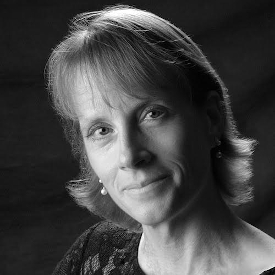
Susan Palo Cherwien was the librettist for Lament of the Earth. Susan passed away in December 2021. (Photo: Paul Mixdorf)
CHERWIEN: So many of us understand power in terms of money, or brute force and Winona LaDuke’s, quote, says it's not those things. It's in your soul. And it's what your ancestors and your old people give you. And that power is in the earth.
[MUSIC: Earth Aria
Music: Steve Heitzeg Libretto: Susan Palo Cherwien
The National Lutheran Choir with Orchestra, David Cherwien, Artistic Director
The Minnesota Boy Choir, Mark Johson, Executive and Artistic Director
Clara Osowski, Mezzo Soprano, David Trembley, Soundmaster Productions
David Trembley, Soundmaster Productions
Lament of the Earth © 2023 National Lutheran Choir]
CURWOOD: Steve Heitzeg composed the music for Lament of the Earth.
HEITZEG: As an artist, I feel I have a responsibility to not only write the music that I hear, but I want to write music that is for positive social change for environmental justice for world peace, because I really feel that the arts can bring people together.
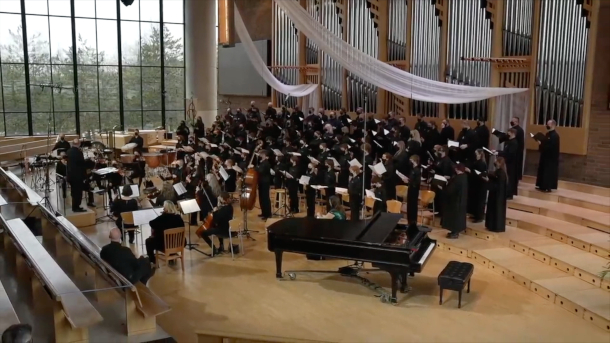
The premiere performance of Lament of the Earth featured the National Lutheran Choir, the Minnesota Boychoir, a string section and percussion section. (Photo: courtesy of Flight Creative Media)
CURWOOD: Why is it important to use art to carry the message of sustainability?
HEITZEG: Well, because I think we've all been gifted with the beauty of nature and to not respect that as an artist or as an individual is just bad karma. I feel it's immoral. It's, it's wrong on many levels. So you know, it's, it's, you know, you want to honor. Things that you respect and that you believe in, you honor. And so writing music as a way of honoring of that for me.
[MUSIC: Ashunu
Music: Steve Heitzeg Libretto: Susan Palo Cherwien
The National Lutheran Choir with Orchestra, David Cherwien, Artistic Director
The Minnesota Boy Choir, Mark Johson, Executive and Artistic Director
Clara Osowski, Mezzo Soprano, David Trembley, Soundmaster Productions
David Trembley, Soundmaster Productions
Lament of the Earth © 2023 National Lutheran Choir]
CURWOOD: Susan Cherwien died before the formal World Premiere of Lament of the Earth, but she did hear her poetry performed by orchestra and choir. Before her passing she spoke of its elements of light and dark.
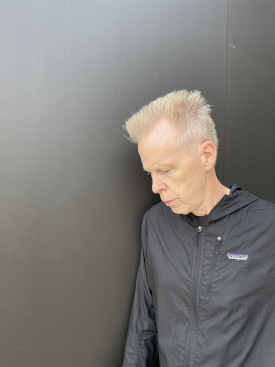
Steve Heitzeg is the composer of Lament of the Earth (Photo: Gwen Pappas)
CHERWIEN: There's a slight shift at the end, create in me a clean heart. Because in order for the forest to be green, the trees have to be green. And in order for society to change and for humanity to evolve, individuals have to evolve. The Earth wants us to evolve. And so we move into the fourth movement where we speak as creatures who have discovered our innate connection and our innate beauty as a part of creation.
[MUSIC: Hozhoogo
Music: Steve Heitzeg Libretto: Susan Palo Cherwien
The National Lutheran Choir with Orchestra, David Cherwien, Artistic Director
The Minnesota Boy Choir, Mark Johson, Executive and Artistic Director
Clara Osowski, Mezzo Soprano, David Trembley, Soundmaster Productions
David Trembley, Soundmaster Productions
Lament of the Earth © 2023 National Lutheran Choir]
CURWOOD: Excerpts of Heitzeg and Cherwien’s Lament of the Earth, performed by the National Lutheran Choir, David Cherwin conducting.
Related links:
- Watch the full Lament of the Earth premiere video
- Read the Lament of the Earth program
- About the late poet and librettist Susan Palo Cherwien
- Visit the National Lutheran Choir’s website
- Learn more about Steve Heitzeg’s music
[Hozhoogo
MUSIC: Steve Heitzeg Libretto: Susan Palo Cherwien
The National Lutheran Choir with Orchestra, David Cherwien, Artistic Director
The Minnesota Boy Choir, Mark Johson, Executive and Artistic Director
Clara Osowski, Mezzo Soprano, David Trembley, Soundmaster Productions
David Trembley, Soundmaster Productions
Lament of the Earth © 2023 National Lutheran Choir]
CURWOOD: Living on Earth is produced by the World Media Foundation. Our crew includes Fern Alling, Naomi Arenberg, Paloma Beltran, Iris Chen, Josh Croom, Swayam Gagneja Mark Kausch, Mark Seth Lender, Don Lyman, Jusneel Mahal, Louis Mallison, Aynsley O’Neill, Sophia Pandelidis, Jake Rego, El Wilson, and Jolanda Omari.
BASCOMB: Special thanks to the National Lutheran Choir, and their occasional double bass player, LOE’s Mark Kausch. Tom Tiger engineered our show. Alison Lirish Dean composed our themes. You can hear us anytime at L-O-E dot org, Apple Podcasts and Google Podcasts, and like us, please, on our Facebook page - Living on Earth. We tweet from @livingonearth. And find us on Instagram at livingonearthradio. And you can write to us at comments at loe dot org.
I’m Bobby Bascomb
CURWOOD: And I’m Steve Curwood. Thanks for listening, and Happy Earth Day!
ANNOUNCER: Funding for Living on Earth comes from you, our listeners, and from the University of Massachusetts, Boston, in association with its School for the Environment, developing the next generation of environmental leaders. And from the Grantham Foundation for the protection of the environment, supporting strategic communications and collaboration in solving the world’s most pressing environmental problems.
ANNOUNCER 2: PRX.
Living on Earth wants to hear from you!
Living on Earth
62 Calef Highway, Suite 212
Lee, NH 03861
Telephone: 617-287-4121
E-mail: comments@loe.org
Newsletter [Click here]
Donate to Living on Earth!
Living on Earth is an independent media program and relies entirely on contributions from listeners and institutions supporting public service. Please donate now to preserve an independent environmental voice.
NewsletterLiving on Earth offers a weekly delivery of the show's rundown to your mailbox. Sign up for our newsletter today!
 Sailors For The Sea: Be the change you want to sea.
Sailors For The Sea: Be the change you want to sea.
 The Grantham Foundation for the Protection of the Environment: Committed to protecting and improving the health of the global environment.
The Grantham Foundation for the Protection of the Environment: Committed to protecting and improving the health of the global environment.
 Contribute to Living on Earth and receive, as our gift to you, an archival print of one of Mark Seth Lender's extraordinary wildlife photographs. Follow the link to see Mark's current collection of photographs.
Contribute to Living on Earth and receive, as our gift to you, an archival print of one of Mark Seth Lender's extraordinary wildlife photographs. Follow the link to see Mark's current collection of photographs.
 Buy a signed copy of Mark Seth Lender's book Smeagull the Seagull & support Living on Earth
Buy a signed copy of Mark Seth Lender's book Smeagull the Seagull & support Living on Earth

